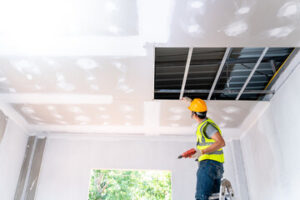Sooner or later, most exterior surfaces need pressure washing. Mildew, dirt and grime build up on concrete, brick, wood and vinyl. Pressure washing can restore surfaces and extend the life of paint jobs.

It is important to use the right pressure settings and techniques to prevent damage. The right nozzle selection can also aid in cleaning surfaces without causing damage. Visit Our Website to learn more.
Using eco-friendly cleaning options and detergents, or even just water, to perform pressure washing eliminates the need for chemical cleaners that can pollute soil and waterways. This reduces the risk of harmful runoff that can damage the environment and kill aquatic life. It also minimizes the amount of waste that is produced, further reducing environmental degradation.
Moreover, by preventing dirt and grime buildup, pressure washing can extend the lifespan of building materials like wood, concrete, and siding. Dirt and grime can actually wear away at surfaces, causing structural damage or even rot. Regular cleanings prevent this from happening, saving business owners money on expensive repair and replacement bills in the future.
Pressure washing can also help improve the aesthetic of your home or business. This can be a major factor in increasing the property value, especially when it comes to selling. It can also make your home or business look more welcoming to visitors, making it a safer place for everyone.
In addition, if you are planning on doing some renovations to your home, such as painting or staining, it is essential that the surfaces are first pressure washed. This ensures that the new material will adhere properly and last longer.
While pressure washing is a great way to remove unsightly dirt, grime, and mold from your property, it can also be used for other maintenance tasks such as gutter cleaning, sidewalk scrubbing, and driveway/patio cleaning. By performing these maintenance tasks regularly, you can avoid costly repairs and maintain a more appealing exterior for your home or business. It is important to note that while pressure washing is an environmentally friendly method of cleaning, it can be an environmental hazard if not done correctly. This is why it is important to hire a professional to handle your pressure washing needs. They will know how to operate the machinery safely and use a low-pressure sprayer that won’t damage your surfaces. They will also use eco-friendly detergents that are biodegradable and free of toxic chemicals. Additionally, they will be sure to recycle the water used for each cleaning, ensuring that no chemicals or waste is left behind.
Saves Time
A good pressure wash takes the guesswork out of cleaning – especially for surfaces that are difficult to reach or would otherwise require hours of scrubbing by hand. A blast of water from a pressure washer gets rid of stubborn stains and pesky mildew with ease, leaving your surfaces looking like new again. That frees up your time to spend on more important things, like hanging out with family or binge-watching your favorite shows.
In addition to saving you time, regular pressure washing prevents damage to your home’s exterior. When grime, moss, and mildew build up on your home, it can eventually cause damage to your siding, driveways, and decks. Pressure washing removes these substances before they can cause any lasting damage, so it’s important to keep up with this preventative maintenance.
As you can imagine, the longer dirt and debris remain on your property, the more costly it will be to remove it. A professional power wash is much less expensive than repairing or replacing damaged areas of your home, so it’s worth the investment.
If you want to save even more money, consider using a soft-washing technique instead of traditional pressure washing. This is a more eco-friendly method of cleaning that uses biodegradable detergents and lower pressure to clean your surfaces.
It’s also a safer choice, as scrubbing with high-pressure water can chip or peel painted surfaces. Pressure washing is typically reserved for outdoor surfaces like patios and decks, as well as concrete and brick driveways, sidewalks, and roofs.
If you’re planning on selling your home in the future, a dirty exterior is one of the most common turn-offs for potential buyers. A thorough pressure wash will leave your home looking like new, boost its curb appeal, and increase its value.
Saves Money
Aside from cleaning away grime and preventing damage to surfaces, pressure washing can also help you save money in the long run. Dirt, mold, mildew, and other contaminants can eat away at the exterior of your home, causing damage that results in costly repairs. Regularly washing your home or business with a power washer prevents this from happening. It’s also a great way to spot any potential problems with your property, such as loose boards or rusting spots.
Boosts Curb Appeal
A fresh coat of paint or a new driveway can drastically increase the value of your home. However, it’s important to get rid of any dirt or mildew buildup before beginning this process. If you neglect to do so, the new coating will begin to peel or chip. Pressure washing is an effective way to clean your entire surface and prepare it for a new coating.
The initial cost of purchasing or renting a pressure washer may seem high when compared to hiring professional cleaners, but it’s important to remember that the machine can be used over and over again. This means that you can reap the benefits of using it over and over again, saving you time and effort in the future.
In addition, pressure washing can be used to improve the longevity of your roof and siding. If left unchecked, algae, moss, dirt, and grime can cause serious damage to your roof or siding, resulting in expensive repairs or replacements. Regularly cleaning your roof and siding with a power washer can prevent this from occurring, and can prolong the lifespan of these materials. This can save you money in the long run, as you’ll need to replace your roof or siding less frequently. This is especially true if you use vinyl siding, which can become discolored and weakened by mold, mildew, or algae. Regularly washing your vinyl siding with a power washer prevents this from occurring and keeps it looking brand new. This is especially helpful if you plan on selling your home in the future, as it will help you get a higher sale price by improving your curb appeal.
Prevents Damage
Pressure washing helps prevent the buildup of dirt and grime, which can damage surfaces over time. It also eliminates the growth of mold, mildew, and other fungi, which can cause structural weakening and deterioration. This prevents rotting, decay, and the need for costly repairs and replacement.
Pressure washers can be used to clean a variety of surfaces, from roofs and driveways to sidewalks and gutters. It’s important to use a suitable nozzle for each surface, and to use the proper water pressure and angle to avoid damaging the material. For example, soft materials like wood may require a lower pressure setting to avoid damage or gouging, while tougher materials can often handle higher pressures.
In addition to cleaning, pressure washing can also be useful for prepping surfaces before painting or other renovations. By removing old paint and preparing the surface for new coatings, it can ensure a better finish and longer-lasting results.
It’s also important to take care when using a pressure washer, to avoid causing damage to nearby plants and structures. To minimize the risk, it’s a good idea to cover any fragile or delicate areas with tarps or plastic sheets before starting. This will protect them from the direct impact of the water, as well as any cleaning agents that may splash or wash off during the process. Alternatively, you can try to redirect the flow of water with barriers or by redirecting nozzles.
As with any home improvement project, there are many benefits to pressure washing. From improving the overall look of your property to boosting its value, it’s an effective and affordable way to keep your space looking great. However, it’s important to take the proper precautions when using a pressure washer, and to ensure your equipment is properly maintained. By following these simple steps, you can safely and effectively pressure wash your home or business without harming the surrounding environment.


